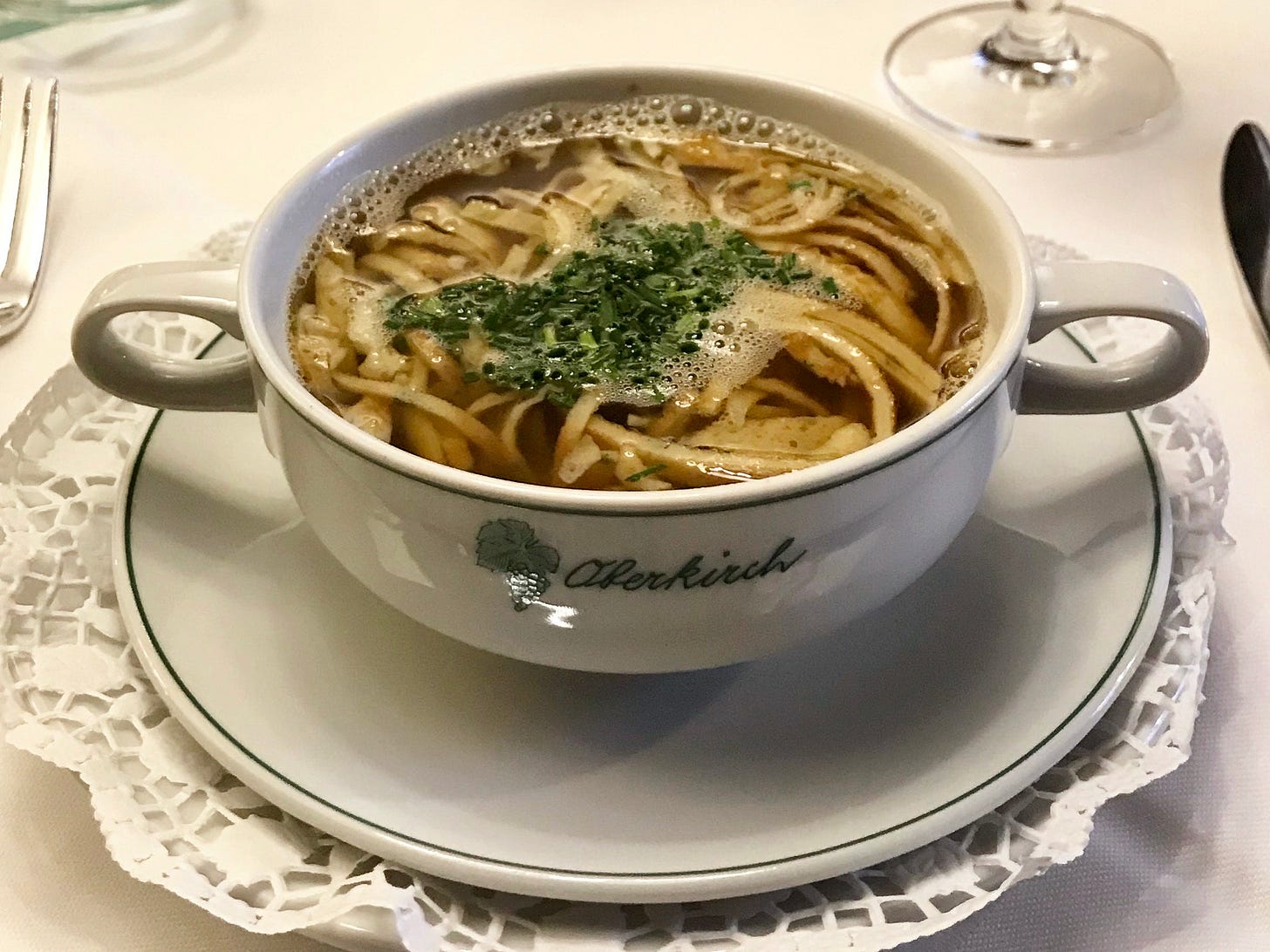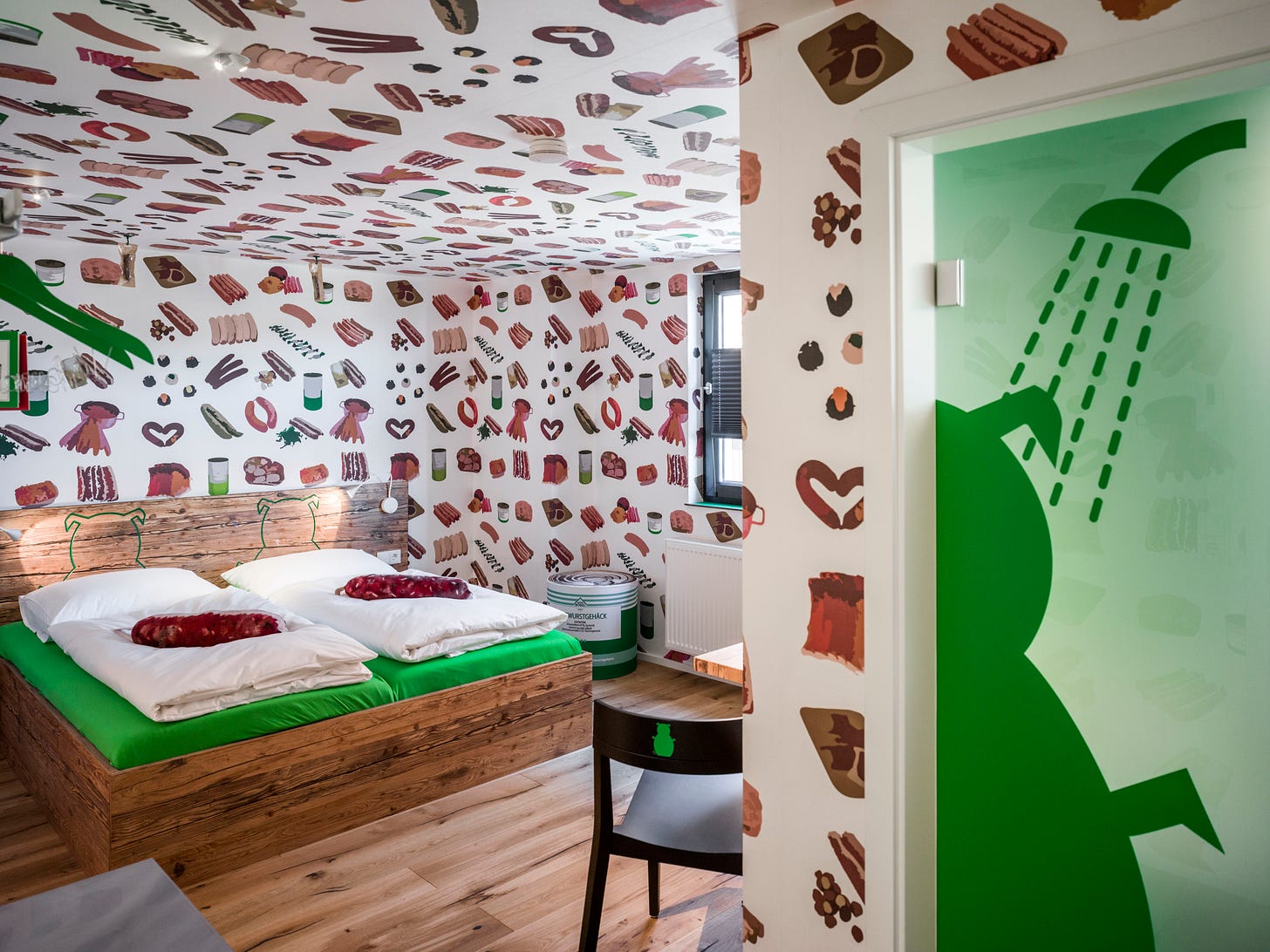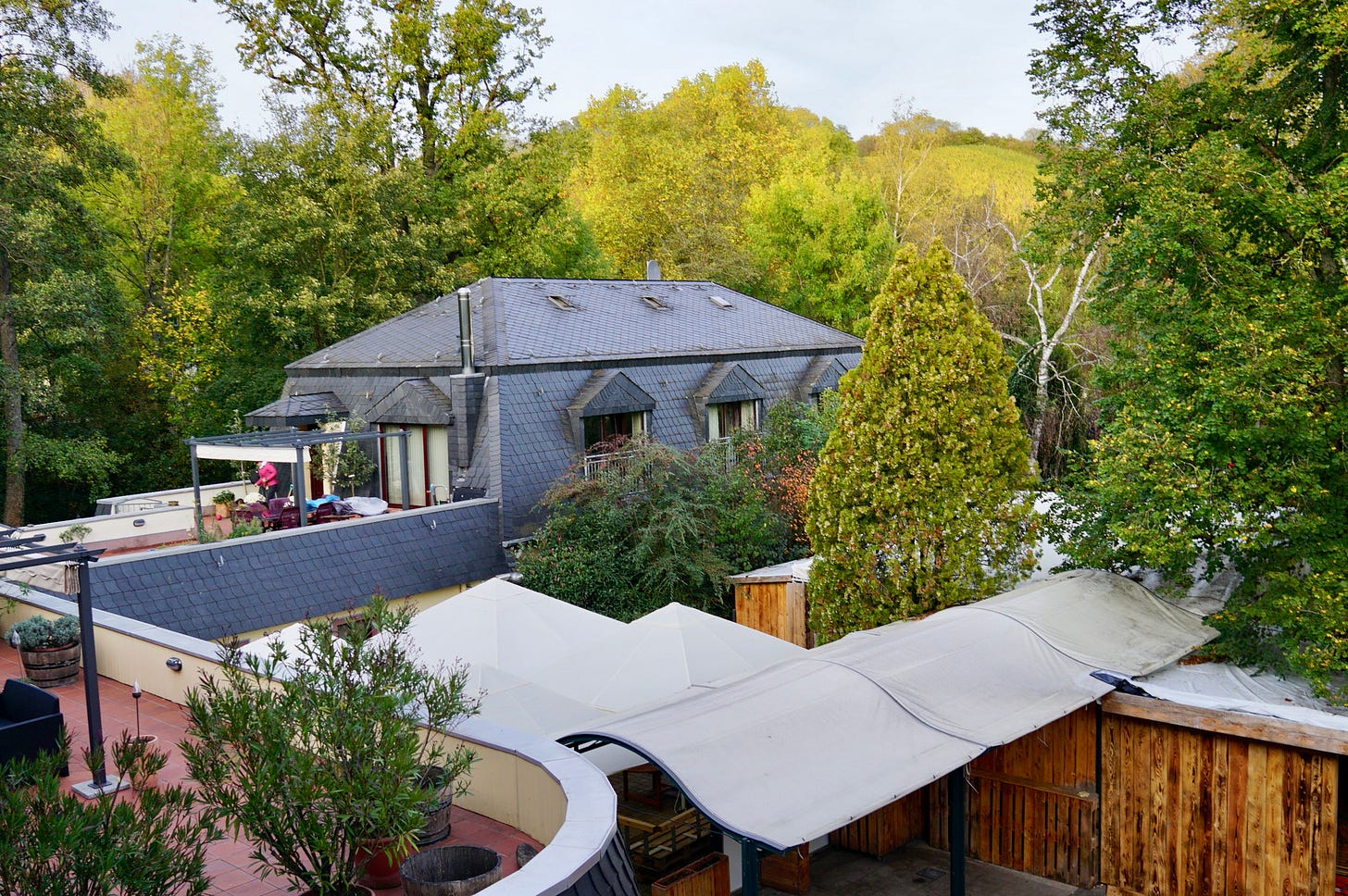Welcome to Germany Travel Picks! This collection of travel tips, inspiration, news and events will land in your inbox every other Tuesday. If you'd like a specific theme or destination covered in a future edition or have feedback on this particular newsletter, please let me know.
In this issue…
Hot waffles with cherries and cream • a plant-based stay in Frankfurt • craft beer hotel surrounded by vineyards • where to eat in Nuremburg • brewery hiking trail • historical Meissen porcelain exhibition…
Destination Picks: Where to eat regional winter specialties
German food may have a reputation for being all pork and potatoes, but look past the sausage options on a restaurant menu and you’ll find all sorts of local specialties that reflect the complex history, landscape, culture and traditions of the region you’re in. You might not expect there to be much variety amongst Germany’s robust winter dishes, but there are plenty of seasonal treats on offer - both savoury and sweet - if you know where to look. Here are three places to try winter specialties to warm yourself up with during the colder months.
Please check individual sites and destinations for up-to-date COVID-19 regulations.
Flädlesuppe in Freiburg
This flavoursome meat or vegetable broth from the southwestern region of Swabia contains thin strips of rolled-up pancake and is garnished with chopped chives. The winter menu at Hotel Restaurant Oberkirch* on Freiburg’s market square offers a nourishing beef version with herby pancakes, which makes for a restorative starter. For a warming winter feast, follow your soup with a venison ragout with lingonberries and homemade Spätzle (egg noodles), and be sure to accompany it all with a glass or two of local wine.
Stewed kale and sausages in the north
Eaten between the first frost in November and the end of February, kale has been one of northwest Germany’s culinary staples for centuries. Locals celebrate kale season throughout the winter with so-called cabbage walks - long, bracing hikes through the countryside accompanied by a wagon filled with booze, which end with a feast of kale and all the trimmings at a restaurant or pub. The hardy, curly leaves are traditionally stewed for hours, usually with onions, schmalz, stock and a little mustard, and served with potatoes and one or more types of regional sausage. At the Bümmensteder Krug, a farmhouse restaurant in the Lower Saxon city of Oldenburg, where some 2000 tons of the green stuff are grown each year, stewed kale comes with Pinkel (pork sausage made with groats), boiled sausage, bacon, Kassler (cured and smoked pork) and fried potatoes.
Hot waffles and cherry sauce close to Kiel
Dat Ole Hus is a small local history museum in the municipality of Aukrug, 35km southwest of Kiel. The main focus of the museum is a half-timbered thatched cottage originally constructed around 1700, the interior of which today portrays the region’s rural living culture from the 1700-1900s. The museum’s cosy café is situated in the cottage’s historically-furnished rooms. Here, you can order waffles prepared in the same way they have been for the last 150 years, cooked in a waffle iron over an open fire and served with hot cherry sauce, freshly whipped cream and a cup of coffee.
Accommodation Picks: Hotels for foodies
Germany Travel Picks supports sustainable overnight accommodation and independent and family-run businesses. Please check individual websites for up-to-date COVID-19 regulations.
Plant-based city stay
The Lindley Lindenberg* hotel-cum-shared-living-space in Frankfurt’s Osthafen neighbourhood offers stylish rooms decorated with locally- and sustainably-made artworks and furnishings, and gorgeous communal spaces for both short- and long-term guests. Its bakery and restaurant serve vegan and vegetarian dishes made with organic herbs and vegetables sourced from Lindenberg’s own permaculture garden in the nearby Taunus mountains. There are also communal kitchens stocked with regional ingredients for self catering, and you can garnish your homemade dishes with herbs from the hotel’s indoor farm. To visit the permaculture garden, book a guided tour with chef Matthias Holfelder (69€), which also includes a vegetarian picnic.
Doubles from From 79€ per night. Further information and booking at thelindenberg.com or book via booking.com.
Sleep under a sausage-filled sky
The BRATWURSTHotel, a converted barn in the village of Rittersbach, Bavaria, is owned by butcher Claus Böbel. There’s a choice of seven individually-decorated bratwurst-themed rooms, the restaurant serves only dishes involving sausages (including dessert - anyone for sausage ice cream?), and you can even book a sausage-making class at Böbel’s butchers shop next door. If you want to write home about your stay here, just ask at reception, and they’ll post off a heart-shaped smoked sausage with a handwritten greeting card for you.
Double rooms from 108€ for two people per night including a sausage breakfast. Further information and booking at umdiewurst.de, or book via booking.com.
A craft beer hotel in wine country
Germany’s oldest wine-growing region may seem like an unlikely spot for a craft brewery hotel, but the family-run Blesius Garten* in the city of Trier doesn’t feel out of place at all. All country house flair, with a small wellness area and easy access to hiking and biking routes around the Mosel, the hotel’s also a ten minute-walk from a 2nd-century Roman amphitheatre. The Kraft Braü’s rustic pub and the hotel’s stylish restaurant, Tonkas, are currently offering a combined menu due to Covid 19-regulation limited seating: choose a three-course menu or hearty main (vegan and vegetarian options available) with a beer pairing, or order a flight of freshly-tapped beers and some bread and pickles served alongside a platter of cold meats from the local butcher.
Doubles from 114€ per night including breakfast. Further information and booking at blesius-garten.de, or book via booking.com.
A Local’s Picks: Where to eat in Nuremberg
Summer Rylander is a freelance food and travel writer from the United States who has lived in Nuremberg since 2015. These are some of her favourite spots to eat and drink in and around (and slightly out of) town.
If you eat meat, Nuremberg’s famous little sausages are a must-try. Spiced with marjoram and strictly regulated in size — each must be between 7-9cm in length and 20-25g in weight — Nürnberger Bratwürste are an important part of the city’s lengthy history. Learn all about them at the recently opened Bratwurst Museum, then order drei im Weggla (“three in a bun”) from one of the many sausage stands around the city. For a sit-down experience, I’m partial to a plate of eight with potato salad at Bratwursthäusle.
My favorite spot for Franconian fare is Zeltner Bierhaus. Located in the neighborhood of St. Johannis, Zeltner serves a superlative Schäufele (an on-the-bone pork shoulder with a marvellous crust of rind) and their Helles Vollbier is excellent, as is their schnitzel, which I consider to be the best in town.
While you’re in Johannis, visit the grave of Nuremberg’s famed painter, printmaker and theorist Albrecht Dürer, then cross the street to Café Dampfudel-Bäck for a plate of their delightful Kaiserschmarrn (sweet fluffy pancakes).
Gostenhof is Nuremberg’s “cool” neighborhood, where you’ll find vintage shops, sidewalk cafes, and lots of great places to eat. Check out 4/20 Chili Lounge for juicy pastrami and salt beef sandwiches to which you can add as much (or as little) housemade hot sauce as you please; have a Rotbier (red beer) and Käsespätzle (cheesy noodles) from Schanzenbräu Schankwirtschaft; or enjoy Georgian food at MER.
If you feel like combining a bit of physical activity with your culinary tour, hop on a local train for a 40-minute journey to Franconian Switzerland. On the Five-Seidla-Trail beer hike, you can hit all five breweries along the one-way route of 10km, or make it a round trip of 19km. You’ll not go thirsty or hungry on this adventure — each brewery has a kitchen that will make you wonder if you should eat now or wait for the next stop — and it’s across gentle terrain that is suitable for nearly all skill levels.
Follow Summer on Twitter and Instagram for more food and travel musings.
Exhibitions for food nerds
The Elementary Parts: From the Collections exhibition features a complete and lovingly restored Frankfurt Kitchen, the iconic precursor to the modern fitted kitchen designed by Viennese architect Margarete Schütte-Lihotzky, from 1929. Museum Angewandte Kunst, Frankfurt. Permanent exhibition.
In 2021, the Meissen Porcelain Collection Ernst Schneider Foundation at Lustheim Palace celebrated its 50th anniversary. The Lust for Lustheim exhibition was created in celebration, and features historical Meissen porcelain alongside contemporary ceramics from all over the world. Lustheim Palace, Oberschleißheim, until 6 June, 2022.
Through multimedia art and interactive scientific displays, Food for the World of Tomorrow addresses what the future of food looks like, focusing not just on politics, but our own personal choices, too. Museum der Brotkultur, Ulm, until 27 February 2022.
You might also be interested in...
British Airways launching direct flights from London Heathrow to Nuremberg • 12 small towns in Germany, from medieval villages to idyllic mountain escapes • The incredible forests of Lipperland •
Has this newsletter been forwarded to you? Why not sign up and receive it straight to your inbox every other Tuesday!
* Entries marked with an asterisk denote that the site was previously visited on a complementary basis for unrelated work purposes, however all editorial is the author’s own. Any sponsored entries, collaborations or advertisements will be clearly marked as such.
Germany Travel Picks is a free newsletter that may include affiliate links, which means the author may earn a small commission if you click through and make a purchase - at no extra cost to you.
Links are provided to English-language websites wherever possible. All details and offers are correct at the time of publishing.








Yum yum yum!!!
It is all very tempting…..